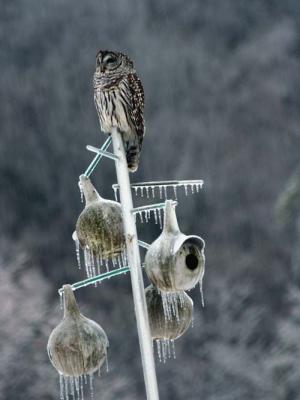- Tags:
- Wildlife,
- Education,
- Forest Journal
A deer stops by a birdfeeder. (Photo: Dan Deegan)
Backyard birdfeeders are magnets for resident winter birds, including turkey flocks. Seed feeders are the wildlife equivalent of the fast food “miracle mile” — calorie alley where it is predictable to find wildlife when food is scarce in winter.
This winter, the forest food pantry is empty. The single most important food source — oak acorns — were non-existent last autumn, the consecutive second consecutive year following the low acorn crop of 2021.
With forest food absent, wildlife patterns change.
Rodent populations have crashed. Lower mouse, chipmunk and squirrel populations mean extrahungry predators risk hunting closer to human homes with better odds of finding prey. Those that are able may temporarily leave the forest: Blue jays disappeared in November due to the poor acorn crop, moving further south and to suburbs.
City squirrels remain fat but much less so out in the woods. The prey base crash in the forest food chain is less apparent in cities and suburban backyards.
Gray squirrels are common all winter at city parks or at backyard birdfeeders. Red squirrels occur where conifer forests with cone seed crops occur.
Chipmunks recently woke during the warm spell.
The deep woods are devoid of white-footed and deer mouse tracks in the snow. Mice are typically abundant, like “burgers and fries” of the forest.
This coming spring, lower rodent birthrates will create a supply chain issue for larger predators most reliant on rodents.
Birdfeeders are attracting attention from hungry hawks and owls this winter.

These raptors are perching closer to backyard birdfeeders hoping to pick off easy meals. Warmerthan- usual winter weather is sparing predators from burning precious calories which is helpful during a particularly lean year of low rodent populations. The most common overwintering hawks include red-tail hawks, a large, chunky hawk often seen along highhways. Red-tail hawks eat squirrels. At birdfeeders, Cooper’s hawks are mid-sized accipiters (birds that prey on other birds) adept at aerial pursuit.
Social media posts reveal more owls at birdfeeders.
Pam Hunt at NH Audubon writes: “Barred Owl productivity is tied to food availability. Although they eat a wide variety of prey, including birds, frogs and snakes, small mammals consistently comprise over 50% of the diet, and local populations of mice, chipmunks, and squirrels can fluctuate widely. When rodents are abundant a pair of owls typically produces 3-5 young, while in years of scarcity they may forego breeding altogether.
“There’s another factor that contributes to the number of owls we see in the winter, and that is weather. When snow blankets the ground, small rodents (mice and voles in particular) can tunnel below it and are harder for owls to detect. The deeper the snow, the more difficult the hunting is, and the owls will shift towards areas with less snow.
“Owls along road are at increasing risk of collisions, while those at feeders can add an occasional bird to their diet of mice and squirrels attracted to spilled seed. An icy crust atop the snow makes hunting more difficult since owls cannot dive into the snow in search of prey they hear beneath it.”
White-tailed deer — the largest prey animals reliant on acorns — have been conspicuous grazing even in daytime on exposed grass or tasty landscape plantings rather than a diet of bitter hemlock bark and hardwood twigs during January in southern New Hampshire. Deer prefer ornamental landscaping: yew hedges, shrubs including forsythia and fruit tree buds and twigs when acorns are unavailable in the forest.
The local deer herd travels easily without wallowing in deep snow.
Closed-canopy, mature forests of pine and hemlock limit sunlight needed to produce the understory of tender sun-loving hardwood saplings which provide winter “browse” for deer. Hardwood bark, buds and tender twigs within reach of browsing deer are scarce in forests lacking openings that regenerate patches of fast growing seedlings and sapling hardwoods. With acorns unavailable, deer are hammering backyard shrubs.
Hungry deer also visit birdfeeders to eat black oil sunflower seeds.
I found a fresh-killed deer carcass in the woods over the arctic-cold Feb. 4-5 weekend. The deer was killed by hungry coyotes, which is more typical in late winter with deeper snow. Vocal crows revealed the location near a funnel at the base of a steep ravine, a location favored by coyotes for ambushing deer driven uphill by other members of the local coyote pack. If rodent populations were higher, it’s likely mice — not deer — would have been on the menu.
Coyotes, foxes and bobcats are hunting closer to fence lines of agricultural fields and pastures, woodland edges and near homes with birdfeeders.
Deer, turkeys and squirrels are now higher on the menu for backyard predators lured closer to where squirrels are most active.
The acorn famine and rodent population crash is a natural cycle in eastern oak forests which dominate the southern New Hampshire. Seed predator starvation is a successful reproductive strategy from the perspective of oak forest regeneration.
Watch for a future bumper acorn crop as the cycle rebounds next autumn or the following year. The rodent crash will ripple across the forest food chain. Predator birth rates will be lower in response to the current food shortage.
.
Dave Anderson is senior director of education for the Society for the Protection of New Hampshire Forests. Contact him at danderson@forestsociety.org.
